Home
Welcome to Ivy's website
Empowering the World with My Data Analysis and Data Engineering Skills

“If you don't produce, you won't thrive - no matter how skilled or talented you are.”
- Cal Newport, Deep Work: Rules for Focused Success in a Distracted World
I am Ivy, a combination of healthcare and data background, am looking for a Data Engineer / Data Analyst position in the UK. Any help will be highly appreciated! I am adept at SQL, Python, and Data Visualisation, I am a certified Azure Data Engineer and GCP Data Engineer, have experience handling large datasets (one published dataset link) and love building data pipelines with Docker and Airflow.
- 3 years, when I studied in a lab, A/B testing to validate my hypothesis
- 2 years, when I worked in a biotech startup, I managed databases, prepared datasets
- 1 year, when I studied Business Analytics, I converted data into business insights
- 2 years, when I self-trained myself, I kept learning data engineering tools

“If you don't produce, you won't thrive - no matter how skilled or talented you are.”
- Cal Newport, Deep Work: Rules for Focused Success in a Distracted World
I am Ivy, a combination of healthcare and data background, am looking for a Data Engineer / Data Analyst position in the UK. Any help will be highly appreciated! I am adept at SQL, Python, and Data Visualisation, I am a certified Azure Data Engineer and GCP Data Engineer, have experience handling large datasets (one published dataset link) and love building data pipelines with Docker and Airflow.
- 3 years, when I studied in a lab, A/B testing to validate my hypothesis
- 2 years, when I worked in a biotech startup, I managed databases, prepared datasets
- 1 year, when I studied Business Analytics, I converted data into business insights
- 2 years, when I self-trained myself, I kept learning data engineering tools

“If you don't produce, you won't thrive - no matter how skilled or talented you are.”
- Cal Newport, Deep Work: Rules for Focused Success in a Distracted World
I am Ivy, a combination of healthcare and data background, am looking for a Data Engineer / Data Analyst position in the UK. Any help will be highly appreciated! I am adept at SQL, Python, and Data Visualisation, I am a certified Azure Data Engineer and GCP Data Engineer, have experience handling large datasets (one published dataset link) and love building data pipelines with Docker and Airflow.
- 3 years, when I studied in a lab, A/B testing to validate my hypothesis
- 2 years, when I worked in a biotech startup, I managed databases, prepared datasets
- 1 year, when I studied Business Analytics, I converted data into business insights
- 2 years, when I self-trained myself, I kept learning data engineering tools
Data Analysis Projects
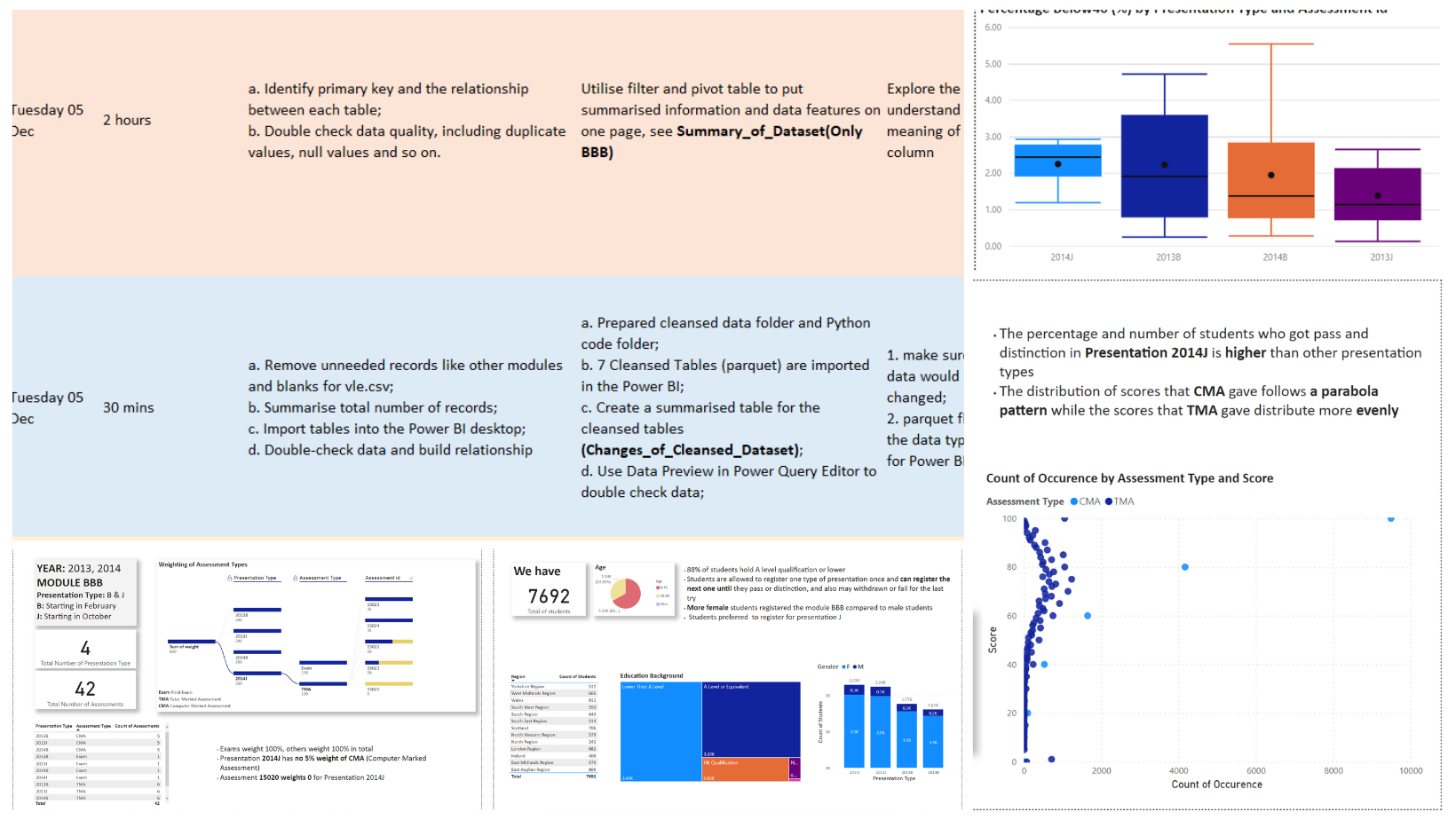
Education-Focused Analysis: How Assessment Types Shape the Final Result
I used Power BI to explore the reasons why the mix and weightings of assessment types shaped the final result
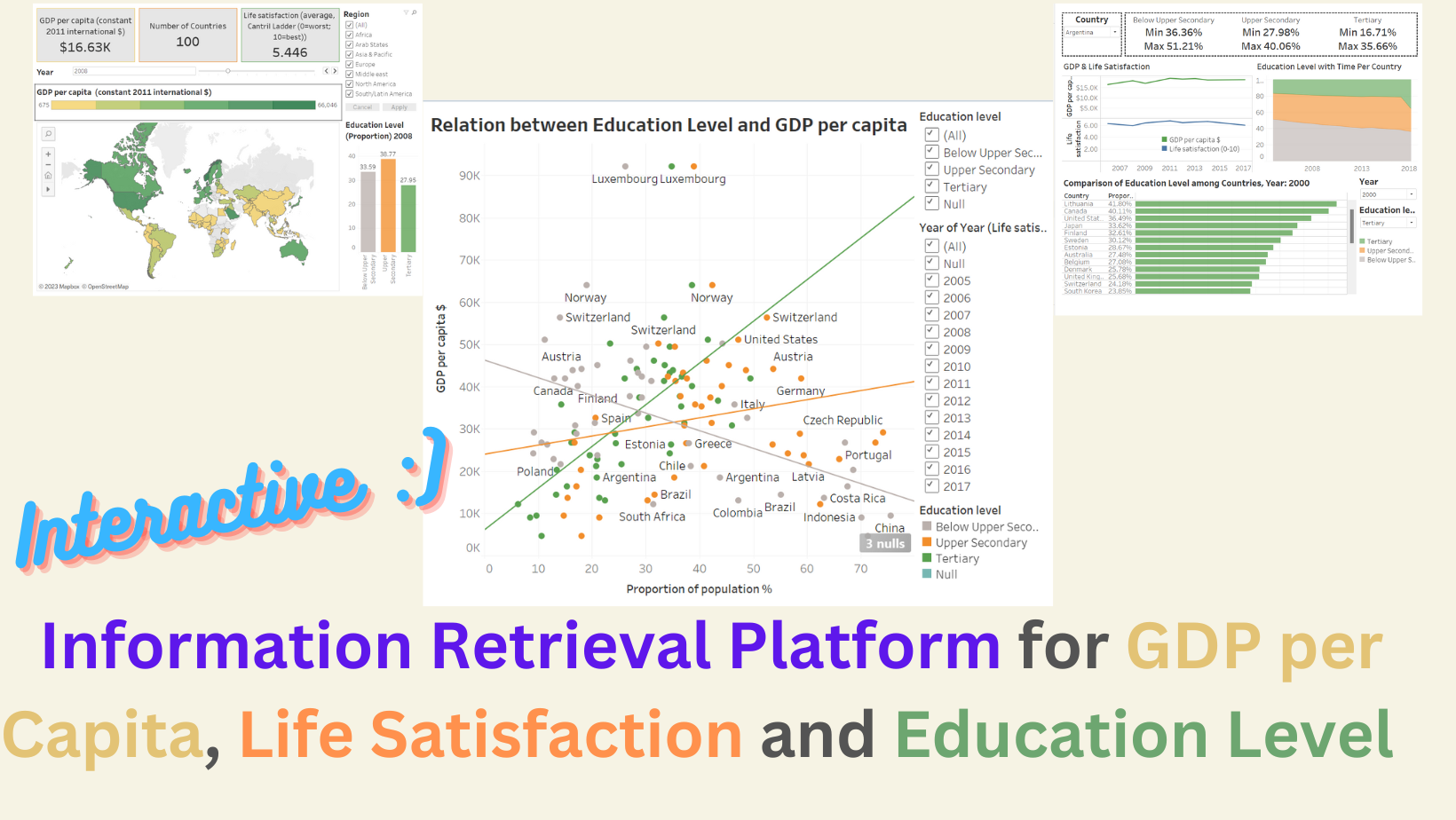
A self-service platform for GDP, Life Satisfaction and Education Level
I used Tableau to build a self-service platform including information about GDP, Life Satisfaction and Education Level
.png)
BT Customer Churn Influencer
I used Power BI to visualise the features of churn customers in BT and used Python and logistic regression to calculate the key churn influencers.

ESG Analysis for Pfizer
I used Python to analyse the position of Pfizer in the pharm industry and linear regression to quantify the relationship between ESG scores and total assets
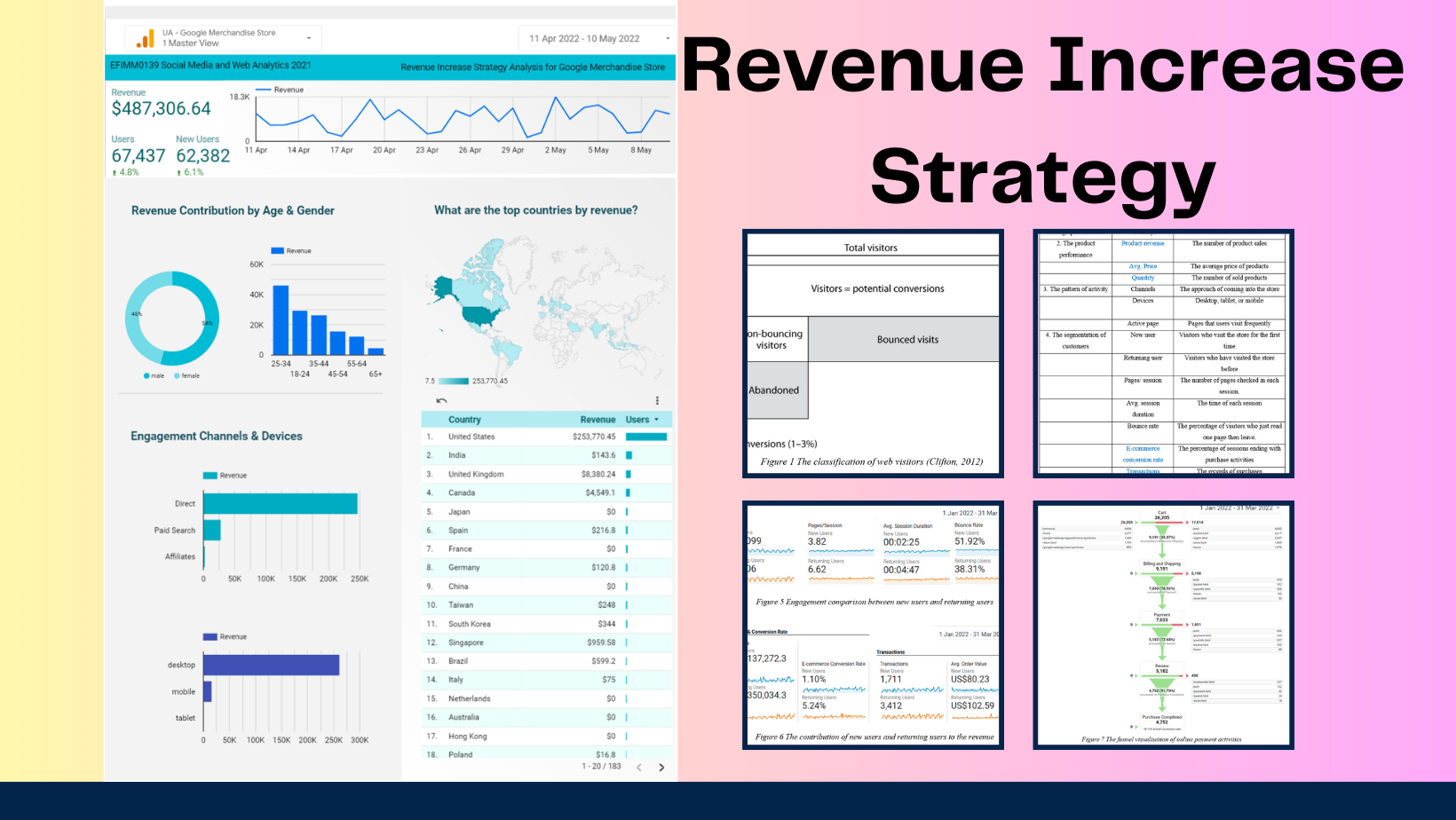
Revenue increase strategy analysis for Google merchandise store
I used Google Analytics and Looker studio to segement customers and analyse customer behaviour
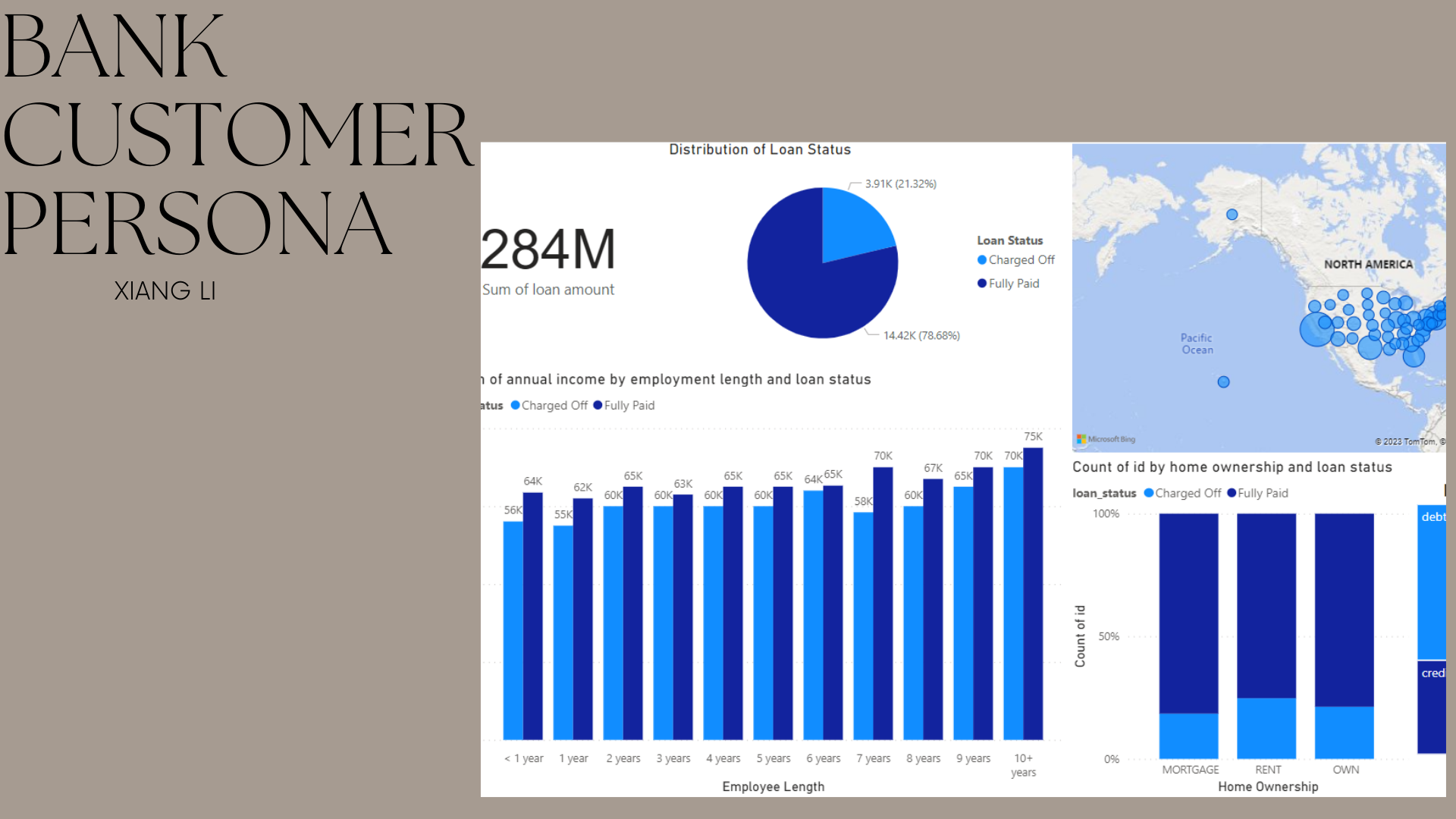
Lloyds Bank Customer Profiling
I used Power BI to profile customers for Lloyds Bank
Database Projects
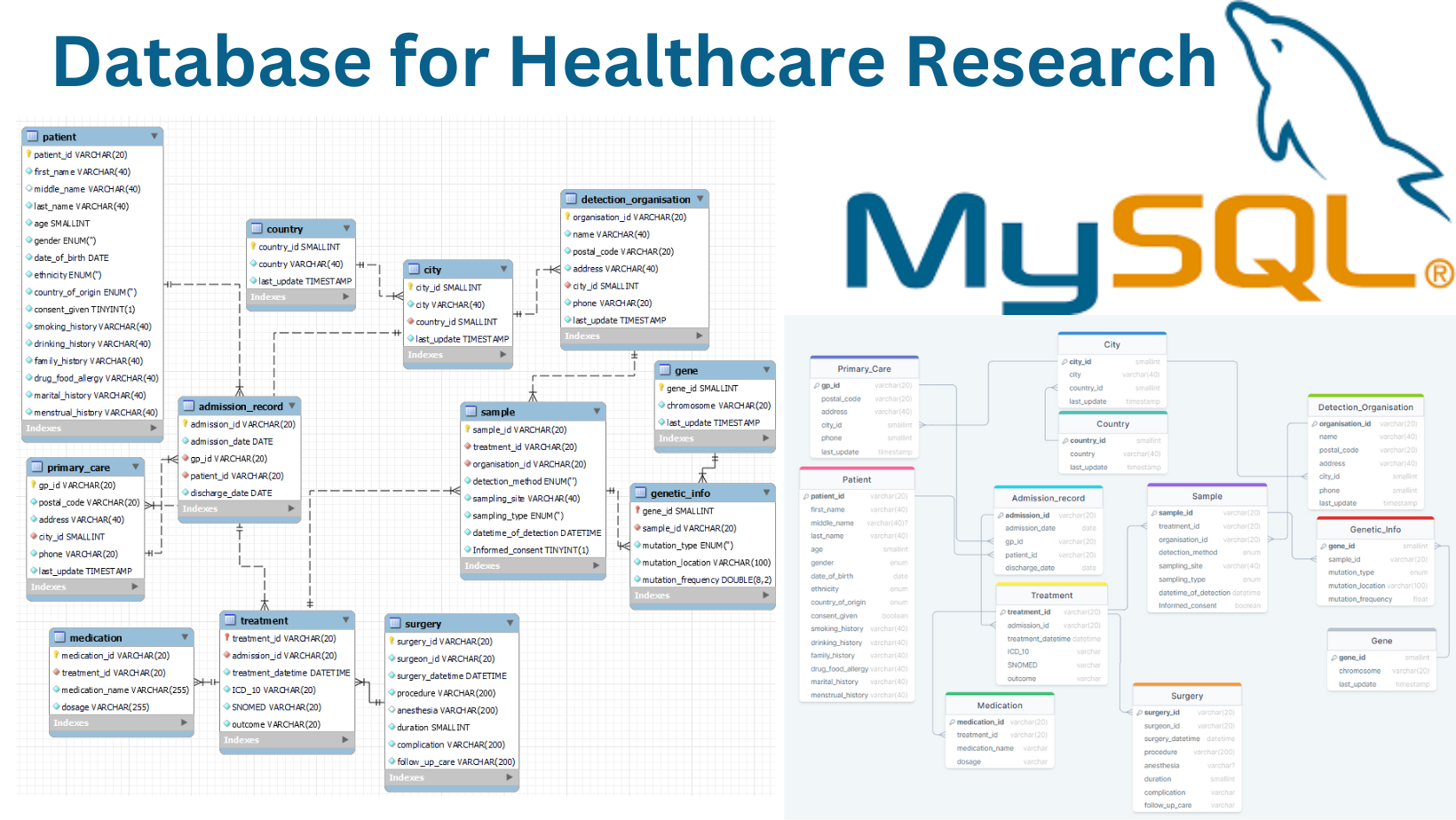
Data Platform Design for Healthcare Research
I used MySQL to create 11 tables for normalisation of clinical data and genetic data. The work is designed for healthcare research.
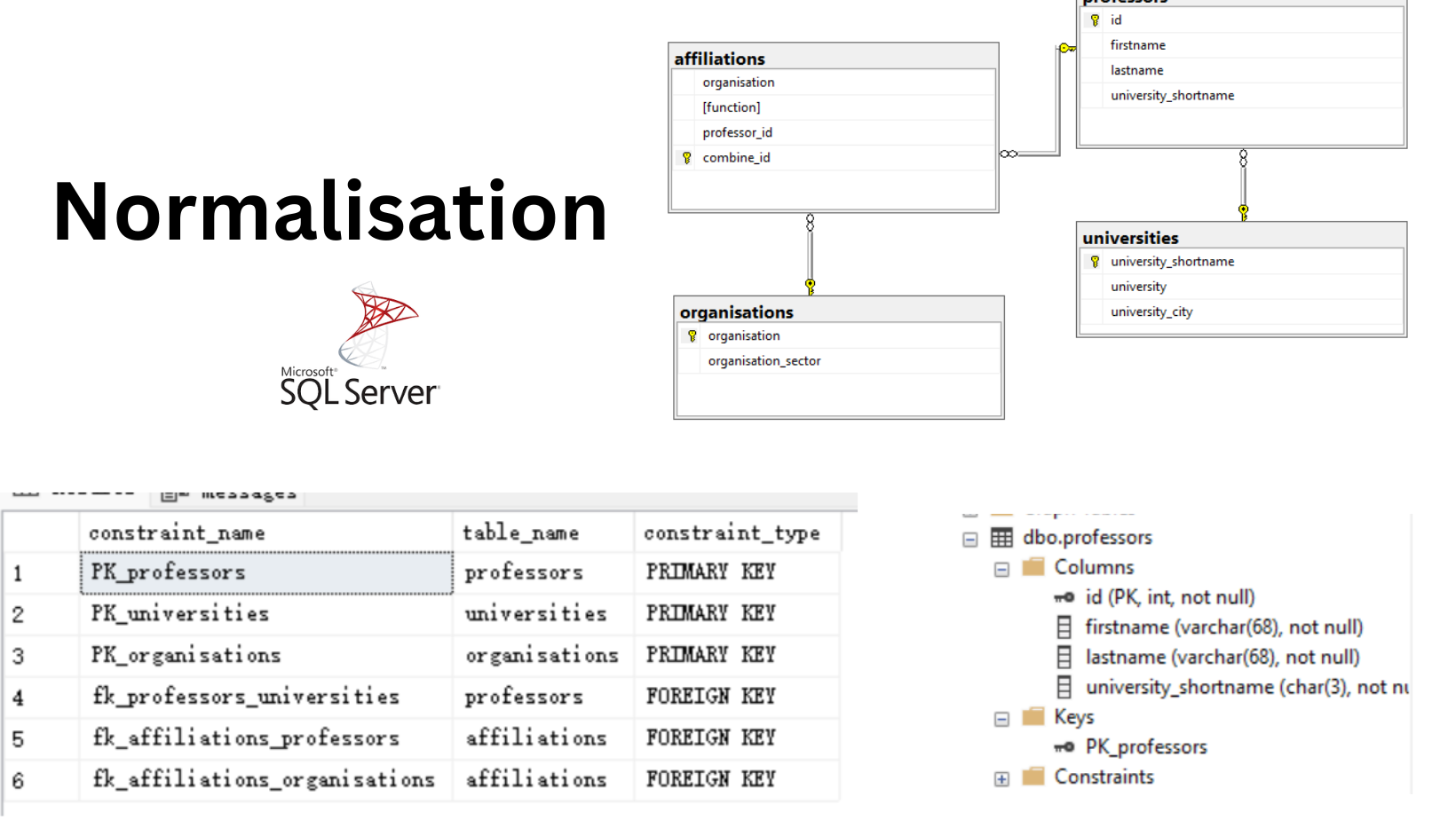
Normalisation for professors in organisations with SQL Server
I used SQL Server to normalise a informative table. The project focused on details, like primary key, surrogate key, relationship, ON DELETE NO ACTION and so on.
Small Projects
.png)
5 Tips to Store an online zip file locally(Python)
In my first blog, I talked about how to create a more structured directory technically, including f-strings, os module, requests and ZipFile library.

3 Steps to Clean Data in SQL Server
I change my on-premise SQL tool to SQL Server now. I prepared clean data for data visualisation, there are 3 main steps to do.
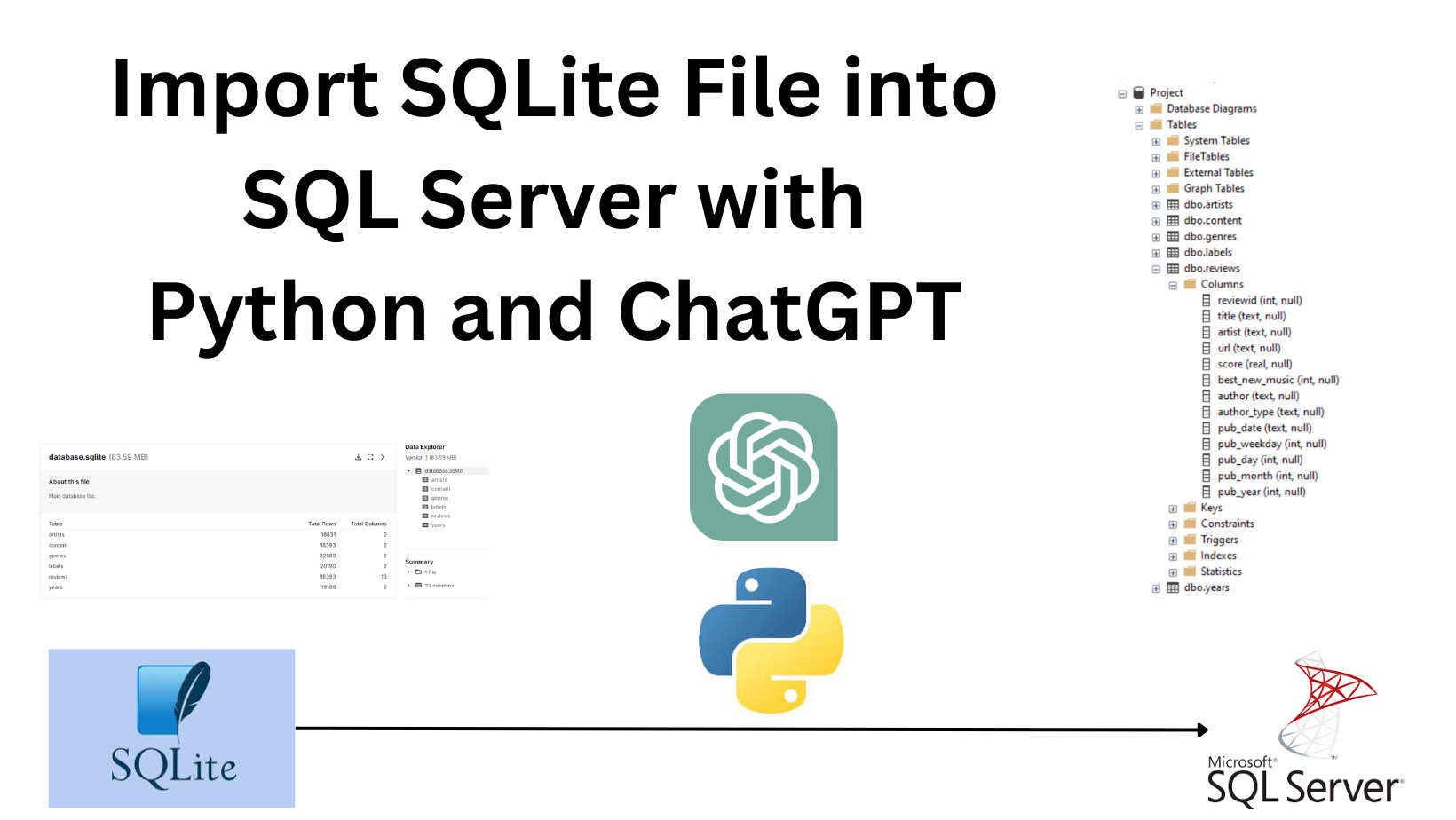
Import SQLite File into SQL Server with Python and ChatGPT
I learn how to use ChatGPT help achieve the connection between SQLite file and SQL Server with Python。
Mini Blogs for Data Analysis Tools
Around 200 to 300 words for an overview
SQL
Introduction
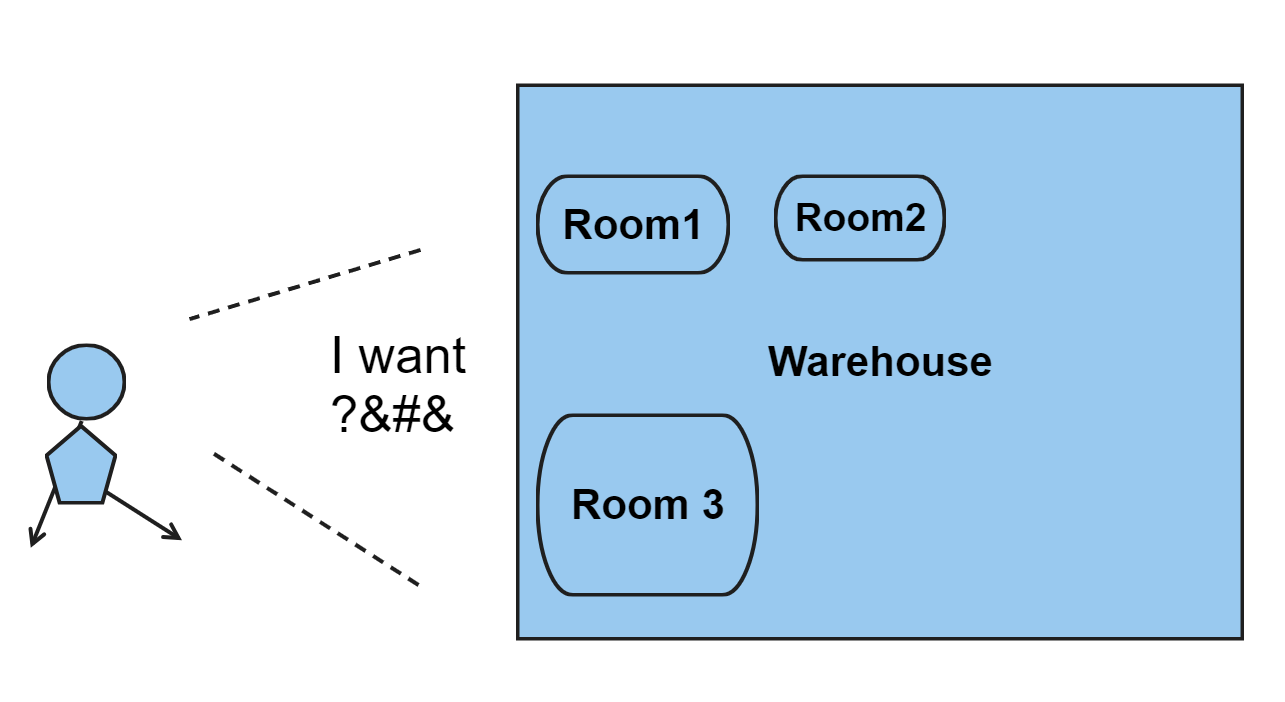
😉Using a simile, SQL is the design of warehouses, and the initial step of the supply chain between the organised warehouse and displayed shops.
💁♀️ So, how does SQL work? Becoming organised (Data Definition, Data Manipulation, Transaction Control, and Data Control) and then choosing the exact products among millions of stored products (Data Query) is what SQL do.
🤓 I need to understand more details about the 5 categories.
Data Definition: design a storage unit with detailed requirements. Each database has some tables, each table has some columns with a certain maximum capacity that holds one data type (e.g., VARCHAR(size), INTEGER(size)). CREATE, INDEX, ALTER, DROP, TRUNCATE, RENAME
Data Management: populate data in the tables. Load the data delivered from the production, add more with time, and replace the unqualified data. The process is dynamic. INSERT, UPDATE, DELETE
Transaction Control: some repetitive tasks can be put together for efficiency and withdrawn in case of errors. COMMIT, ROLLBACK, SAVEPOINT
Data Control: permission control for safety. Only specified users can access the database. GRANT, REVOKE
Data Query: choose data with filters, adjustments, and simple mathematics. a. Select information for a specific date, people, or region. SELECT, DISTINCT, WHERE, IN, LIKE; b. Some tables have relationships and can be merged. JOIN, UNION, INTERSECT, EXCEPT; c. Aggregate data in groups. GROUP BY, SUM, MAX; d. Adjust raw columns for a new format. CONCAT, DATEADD, LENGTH, SUBSTRING; d. Conditional output. CASE WHEN, IS NULL and so on.
😚 In short, database administrators are responsible for the database design and management while data analysts find the right data using the last query language. Now that I know what SQL does and how it works, I can practice getting data using these functions.
Query Language
Functional Language

😁 I want to continue to have a more detailed framework for the query language branch.
Imaging I have several tables to extract data, what data do I want?
💪 The most frequent steps are:
Step 1. Choose tables with FROM
Step 2. Add conditions with WHERE (=, non-equals, BETWEEN, IN, LIKE)
Step 3. Choose columns with SELECT and simple aggregation {COUNT, MAX, MIN, AVG, SUM, DISTINCT}
Step 4. ORDER BY to sort out the rows and LIMIT to choose the specific amount from the beginning
👉 The possible scenes are:
Option 1. Merge columns into one table with JOIN {LEFT, SELF, FULL, CROSS} and ON (=), USING; Merge rows into one table with UNION {INTERSECT, EXCEPT}
Option 2. Classify all rows into groups for calculation and comparison {GROUP BY, HAVING}
Option 3. Add new aggregated or transformed columns in temporary WINDOWs and add new values to each row, WINDOW can be one if ignores the PARTITION BY
Aggregation functions MIN / MAX/ AVG/ SUM (…) OVER(PARTITION BY…)
Ranking in groups RANK()/ DENSE_RANK() OVER(PARTITION BY… ORDER BY…)
Move the value up or down LEAD/LAG (…, offset) OVER(ORDER BY…)
Create a WINDOW related to the current row OVER(ORDER BY… ROWS/RANGE/GROUPS BETWEEN {n /UNBOUNDED PRECEDING, CURRENT ROW} AND { n /UNBOUNDED FOLLOWING, CURRENT ROW})
💁♀️ The special techniques are:
Technique 1: Use () to combine queries, called subquery, the latter can use the output of the former one
Technique 2: Create Common Table Expression (CTE) to create a temporary table for simplification WITH table_name AS (……)
Technique 3: Define a Window then OVER it in SELECT clause {WINDOW window_name AS (PARTITION BY…)}
✌ With this, I can solve problems by combining them together. The more questions I solve, the more functions I will know, and the framework will be enriched.
Power BI Desktop
Introduction
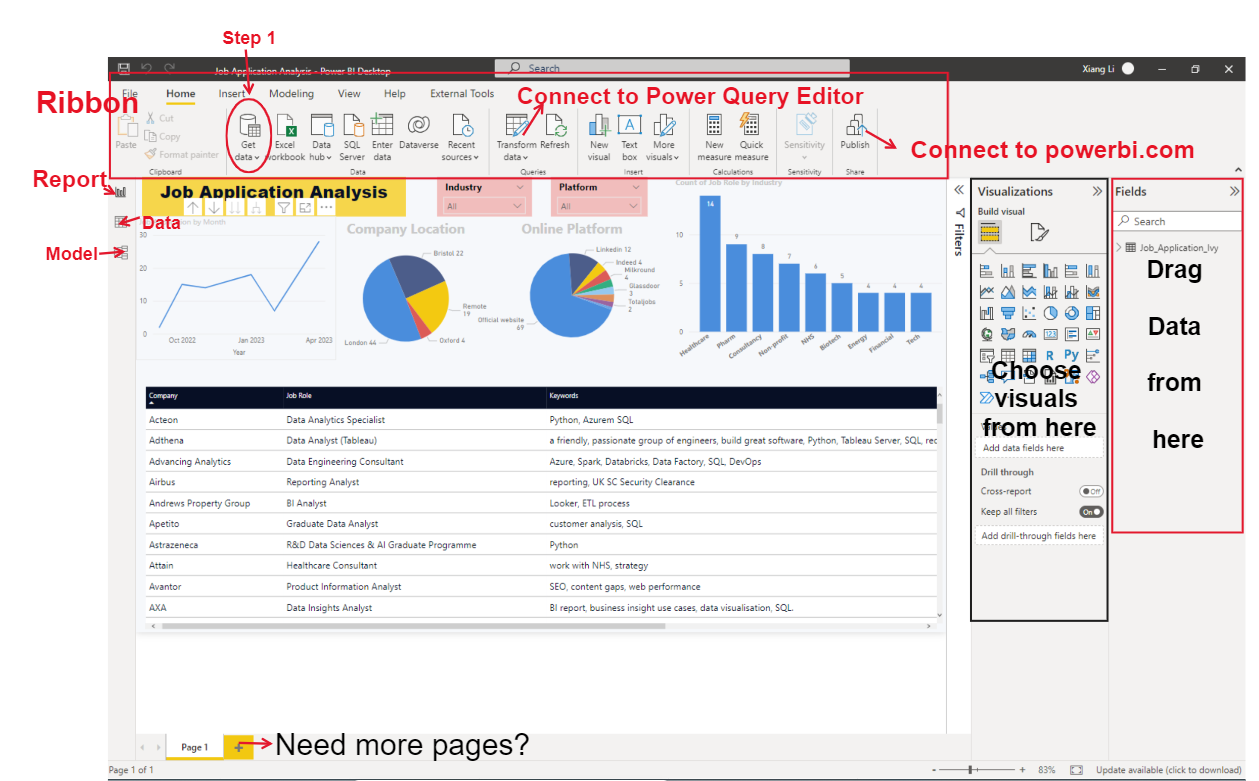
😜 Wish the sunshine coming back. Today, I want to explain the Power BI Desktop fundamentals concisely.
🤔 Why do we need Power BI? Because we need to tell stories to end users. Power BI can hold datasets and visualise them, showing massive information simultaneously on several pages.
🤗 So how does it work? Power BI Desktop has two main parts, the main interface (including report, data and model three layers) is for data modelling and visualisation. For the data transformation purpose, Power Query Editor support this part.
💁♀️ Then the common steps are:
Step 1: Get Data from connectors, they can be Files (e.g., Excel, CSV), databases (e.g., SQL Server), and URLs (e.g., SharePoint).
Step 2 (Optional): Sometimes, we do not have permission to change the raw data or our requirements are personalised. We need to adjust the data before loading. View column quality and distribution, Pivot or Unpivot, Split and so on.
Step 3: The model layer can build relationships among tables for joining tables together, and may add new measures or columns (it won’t change source data).
Step 4: Choose visuals on the right area, then drag data from fields into values, and may legend.
🙆♀️ That’s it, I hope it is helpful for my friends who want to learn a data visualisation tool.
Power BI Service
Introduction
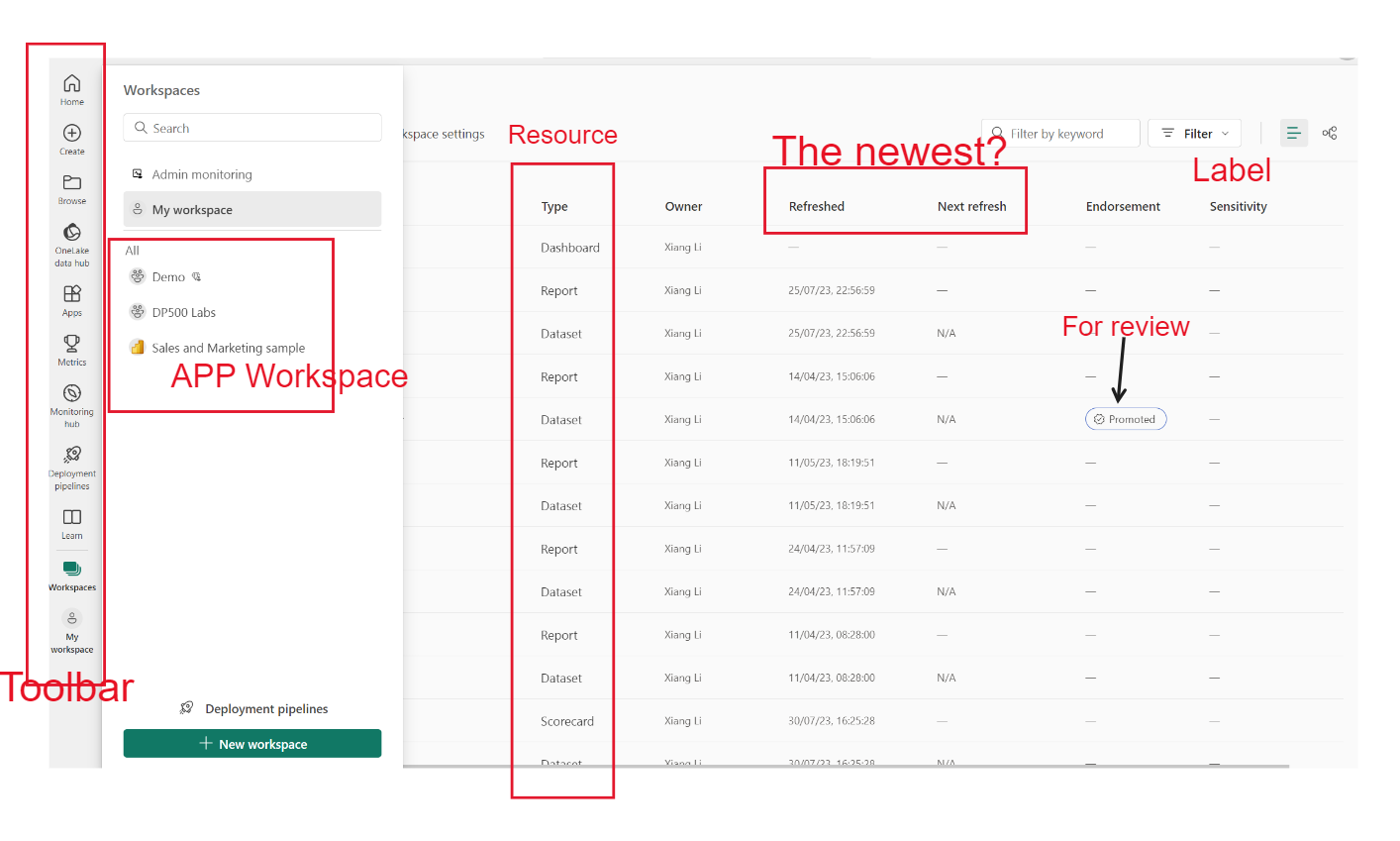
😘 At the beginning of another rainy week. I want to continue introducing the Power BI service.
🤔 𝐖𝐡𝐲 𝐝𝐨 𝐰𝐞 𝐧𝐞𝐞𝐝 𝐭𝐡𝐞 𝐏𝐨𝐰𝐞𝐫 𝐁𝐈 𝐬𝐞𝐫𝐯𝐢𝐜𝐞? Publish reports from the Desktop to the Service means moving reports from local to shared networking, others can also utilise our work.
💁♀️ 𝐒𝐨 𝐡𝐨𝐰 𝐝𝐨𝐞𝐬 𝐢𝐭 𝐰𝐨𝐫𝐤?
a. It is a web-based resource management platform.
b. It holds my workspace (highest private) and can also create APP workspaces to group and share resources under our account, each workspace can have datasets, reports, dashboards, dataflows, datamarts (premium tier: support Power Query Editor + SQL/Visual query + Report Building, provide Desktop experience), and scoreboards.
c. Premium tier also has the deployment pipeline function which can help development by staging workspaces.
d. These resources can be shared extensively via creating APPs.
👉 𝐓𝐡𝐞 𝐟𝐨𝐥𝐥𝐨𝐰𝐢𝐧𝐠 𝐪𝐮𝐞𝐬𝐭𝐢𝐨𝐧𝐬 𝐚𝐫𝐞: 𝐇𝐨𝐰 𝐭𝐨 𝐦𝐚𝐢𝐧𝐭𝐚𝐢𝐧 𝐚𝐧𝐝 𝐬𝐞𝐜𝐮𝐫𝐞 𝐝𝐚𝐭𝐚 𝐢𝐧 𝐭𝐡𝐞 𝐒𝐞𝐫𝐯𝐢𝐜𝐞 𝐰𝐡𝐞𝐧 𝐭𝐡𝐞 𝐝𝐚𝐭𝐚 𝐛𝐞𝐜𝐨𝐦𝐞𝐬 𝐡𝐚𝐥𝐟-𝐩𝐮𝐛𝐥𝐢𝐜?
Firstly, schedule refresh for the updated information and apply sensitivity labels for datasets if needed.
Secondly, for internal workers during the development process, grant them one of 4 roles with the least privilege to change the workspace: Viewer < Contributor < Member < Admin
Thirdly, for consumers or external users, grant them viewer roles for the published APPs.
Additionally, in one report, row-level security can make sure viewers only read the information they need.
😁 Hope this post can give you a general overview of the Power BI service and make it easier to explore it. Have a nice following week.
Power BI DAX
Functional Language
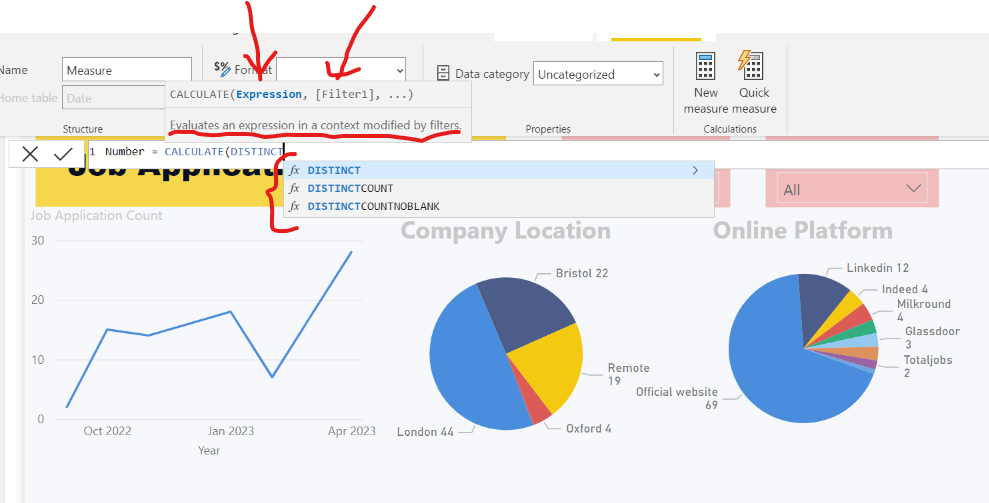
🤗 At the beginning of August, I want to introduce the core power of Power BI: DAX (Data Analysis Expression)
🤔 𝐅𝐢𝐱𝐞𝐝 𝐐𝐮𝐞𝐬𝐭𝐢𝐨𝐧: 𝐖𝐡𝐲 𝐝𝐨 𝐰𝐞 𝐧𝐞𝐞𝐝 𝐃𝐀𝐗? DAX, as its name, is mainly for Data Analysis, in other words, it provides more flexibility to handle analysis
💁♀️ 𝐒𝐨 𝐡𝐨𝐰 𝐝𝐨𝐞𝐬 𝐢𝐭 𝐰𝐨𝐫𝐤?
It calculates existing data to get new data with functions.
It has three final formats: measure, calculated column, and calculated table.
𝐌𝐞𝐚𝐬𝐮𝐫𝐞 is like a set of procedures to calculate; it will be calculated again when it is used in the report under context.
𝐂𝐚𝐥𝐜𝐮𝐥𝐚𝐭𝐞𝐝 𝐂𝐨𝐥𝐮𝐦𝐧 is added to the data table for each row, it would not influence the source data but it is kept in the model
𝐂𝐚𝐥𝐜𝐮𝐥𝐚𝐭𝐞𝐝 𝐓𝐚𝐛𝐥𝐞 is often used to create a date table for hierarchy (the results can be analysed by year, quarter, month, and day)
👉 𝐖𝐡𝐚𝐭 𝐚𝐬𝐩𝐞𝐜𝐭𝐬 𝐝𝐨𝐞𝐬 𝐢𝐭 𝐜𝐨𝐧𝐭𝐫𝐢𝐛𝐮𝐭𝐞?
The most common and complex one is Analysis using aggregation, logical, date, and filter functions
Active relationship when there are multiple foreign keys in one table with 𝐔𝐒𝐄𝐑𝐄𝐋𝐀𝐓𝐈𝐎𝐍𝐒𝐇𝐈𝐏( )
Simplify row-level security by combining the user identity table and 𝐔𝐒𝐄𝐑𝐏𝐑𝐈𝐍𝐂𝐈𝐏𝐀𝐋𝐍𝐀𝐌𝐄( )
🤓 𝐈 𝐰𝐢𝐥𝐥 𝐧𝐨𝐭 𝐥𝐢𝐬𝐭 𝐞𝐯𝐞𝐫𝐲 𝐟𝐮𝐧𝐜𝐭𝐢𝐨𝐧 𝐛𝐮𝐭 𝐬𝐡𝐚𝐫𝐞 𝐡𝐨𝐰 𝐭𝐨 𝐥𝐞𝐚𝐫𝐧 𝐢𝐭 𝐞𝐟𝐟𝐢𝐜𝐢𝐞𝐧𝐭𝐥𝐲.
Tip 1: Have a look at the official document (link: https://lnkd.in/e5nFmMH8) or Learn path (link: https://lnkd.in/ewSGXZyj). The document classifies DAX functions and provides examples, we will have a general idea about what functions they have.
Tip 2: Each function will be explained clearly in the 𝐓𝐨𝐨𝐥𝐭𝐢𝐩 when entering ‘(‘ after the function, read what it is and what parameters it needs.
Tip 3: Variables can be brought in when the measure becomes complex.
😊 Happy Power BI.
Apache Parquet
Efficient File Type
Features:
Columnar-storage
Compressed with the Dictionary or Run-Length Encoding (RLE) when the column has duplicate values
Dictionary suits for repetitive categorical data, e.g., music genres
RLE suits for Data with long sequences of the same value, e.g., consecutive 'Open' or 'Closed' for stores
Small size
Metadata stores schema
Strong Data Integrity
Support nested data structure
Storage:
Row Groups: each row group contains a set of rows for each column
Column Chunks: each column within a row group is stored in a "chunk"
Encoding and Offsets: Dictionary or Run-Length Encoding (RLE)
Metadata: describes the structure of the data, including the schema and the encoding used for each column
Reconstruction During Reading: the process above reverses
A Simple Metadata Examples:

Python
List Key Tools of Python
Data Structures - Set
my_set = {1, 2, 3}
Unordered, no index
Unique Elements
Heterogeneous, can contain integers, strings, tuples and so on at the same time
Immutable Elements, can not be changed but can be added or removed
Not require contiguous memory, hash table structure (an array of 'buckets')
Use cases:
membership testing
remove duplicates
operations, like unions
|, intersection&, difference-, symmetric difference^, issubset( ), isdisjoint( )
my_set = {1, "hello", (2, 3)} #integer, string and tuple
another_set = set([4, 5, 6]) #set function converts a list into a set
# add elements
my_set.add(4)
# remove elements
my_set.remove(4)
# membership testing, O(1)
2 in my_set
# set operations
union_set = my_set | another_setData Structures - Tuple
my_tuple = (1, "hello", 3.14)
0-based Indexing, access elements by their position with `[ ]`
Heterogeneous Data contain different data types, including other tuples, lists, and dictionaries
Immutable Tuple, once a tuple is created, elements of it can not be added, changed, or removed, but elements themselves can be modified if they are mutable objects
Contiguous Memory
Use cases
Return values in function
Immutable Data Collection
Represent a row with columns as elements for databases
Dictionary keys
my_tuple = ([1, 2], "hello")
my_tuple[0].append(3)
print(my_tuple) # Output: ([1, 2, 3], "hello")
# tuples without parentheses
another_tuple = 1, 2, 3
# single-element tuples
single_element_tuple = (1,)
# complicated tuples
book = (
{"title": "1984", "author": "George Orwell", "publication_year": 1949},
["Dystopian", "Political Fiction", "Social Science"],
(True, "John Doe")
)#Accessing book information
print(f"Title: {book[0]['title']}")
print(f"Author: {book[0]['author']}")
print(f"Genres: {', '.join(book[1])}")
print(f"Is Borrowed: {'Yes' if book[2][0] else 'No'}")Data Structures - Arrays Build-in
int_array = array('i', [1, 2, 3]) # Array of integers (less used)
Created using the
arrayclass fromarraymodule0-Based Indexing
Homogeneous, the type of elements is determined by a type code
iMutable, can modify the elements, append, or remove
Contiguous Memory
Store the data values themselves in the contiguous block (memory efficient)
Use case
large numeric datasets
binary I/O operation
from array import array
int_array = array('i', [1, 2, 3])
print(int_array)
# Output is array('i', [1, 2, 3, 4, 5])
# access elements with index
print(int_array[0])
# Output is 1
# add new element
int_array.append(4)
print(int_array)
# Output is array('i', [1, 2, 3, 4, 5, 4])Data Structures - 2D Arrays (Matrix)
my_numpy_array = np.array([[1, 2, 3], [4, 5, 6]])
Support Multidimensional Indexing, access elements using a comma-separated tuple of indices
Homogeneous, the same data type (improve efficiency)
Mutable, modifying elements or reshaping it
Contiguous Memory, is a fixed size determined at the time of creation
Use case
Matrix Computation
Scientific Computing
Linear Algebra
Large datasets
import numpy as np
# create a 2D array (matrix)
matrix = np.array([[1, 2, 3], [4, 5, 6], [7, 8, 9]])
# access elements with index
row2_column3 = matrix[1, 2]
# change the elements
matrix[1, 2] = 20
# matrix computation
matrix_a = np.array([[1, 2], [3, 4]])
matrix_b = np.array([[5, 6], [7, 8]])
matrix_sum = np.add(matrix_a, matrix_b)
# Matrix multiplication
matrix_product = np.dot(matrix_a, matrix_b)Data Structure - Lists Build-in
my_list = [1, "Hello", 3.14, [2, 4, 6]]
- 0-based Indexing and slicing
- Multidimensional List
- Heterogeneous Data Types
- Mutable
- Dynamic resizing and memory overhead (e.g.,
appendremoveinsertpop) - Concatenation (+) and Repetition (*)
- Sorting and Reversing
#Creating a list and adding elements
my_list = [1, 2, 3]
my_list.append(4) # Add at the end
my_list.insert(1, 'a') # Insert at index 1#Accessing elements
print("First element:", my_list[0]) # Access first element#Modifying elements
my_list[2] = 'b' # Change the element at index 2
#Removing elements by value and by index
my_list.remove('a') # Remove the first occurrence of 'a'
popped_element = my_list.pop(2) # Remove and return the element at index 2
#Slicing
sublist = my_list[1:2] # Elements from index 1
#Concatenation and repetition
another_list = ['a', 'b']
con_list = my_list + another_list
rep_list= my_list * 3
#Sorting and reversing
my_list.reverse()
con_list.sort(key=str) # Convert all elements to strings
# Multidimensional list
matrix = [[1, 2, 3], [4, 5, 6], [7, 8]]Positional and Named Parameters
Positional parameters are based on the order in which I provide them.
def create_pizza(cheese, tomatoes, olives):
return f"Created a pizza with {cheese} cheese, {tomatoes} tomatoes, and {olives} olives."
# The sequence of parameters matters
my_pizza = create_pizza("mozzarella", "cherry", "green")
print(my_pizza)To compare, Named (Keyword) Parameters
def create_pizza(cheese, tomatoes, olives):
return f"Created a pizza with {cheese} cheese, {tomatoes} tomatoes, and {olives} olives."
my_pizza = create_pizza(tomatoes="cherry", cheese="mozzarella", olives="green")
print(my_pizza)Class
class Solution: def My_Method(self, word1: str, word2: str) -> str:
A blueprint for creating objects
Group data (Class attributes and Instance attributes) and functions (methods)
Each method in a class must have
selfas its first parameter, which refers to the instance of the classCreate an instance from the defined class, my_solution = Solution( )
#how to use class and methods included
#Create an instance of Solution, which is my_solution
my_solution = Solution()
result = my_solution.My_Method("abc", "pqr")
print(result)Debug Methods
Debugger VScode (what is going on inside of the code?)
The common tool is print(), especially for the loop, it is easy to check the changes in each loop
VSCode Debugger is a powerful tool to check the program flow:
Step 1: Install Python Extention to enhance the RUN AND DEBUG feature
Step 2: Open the folder and create a 'launch.json' file for future customisation
breakpoint: where to pause the execution
Debug Cell (More near Execute Cell icon)


The following sequence is Continue, Step Over, Step Into, Step Out, Restart, Disconnect
- Continue: continue execution of this line until the end of the code cell
- Step Over: execute this line of code then pause execution at the next line of code
- Step Into: dive into this line of code and see details like what functions this line of code borrowed from other places in the same cell
- Step Out: jump out from the function inside and back to the main
- Restart: restart the debugging
- Disconnect: end the debugging
Key Points in Computer Science
A short summary for key concepts in CS50
BITS, BYTE
Pre-study
Data is saved as 1 and 0 (i.e., the binary system) in a computer
BIT (BINARY DIGIT): The smallest unit, i.g., 1 or 0
Bytes: = 8 BITS, i.g., 01011011
KB (KILOBYTE): =1,024 BYTES i.g., space for around 1/3 Page of Text
MB (MEGABYTE): = 1,024 KB, i.g., space for 1 book, 1 photo, 1 minute of music
GB (GIGABYTE): = 1,024 MB
TB (Terabytes): = 1,024 GB
...
The number of values that BIT can represent is 2^ (the number of BITS) - 1
Data Types (C Programming Language)
CS50 Week1 C
int: integer, 4 bytes of memory (32 bits), The biggest number that the binary system can represent (32-bit) is 11111111,11111111,11111111,11111111 which is 2147483647 (considering the negative number). The range is -2^31 to 2^31-1
unsigned int: double positive range but disallow negative value. The range is 0 to 2^32-1
long: 8 bytes of memory (64 bits). The updated version of int. Larger range.
char: single character, 1 byte of memory (8 bits), ASCII maps numbers to these characters, i.g., for A: 0100 0001. The range is -2^7 to 2^7-1`
float: floating points, 4 bytes of memory (32 bits), the precision is restricted
double: floating points, 8 bytes of memory (64 bits), more precise
bool: true or false
string: an array of characters
Command Line
CS50 Week 1 C
clear (Ctrl + l): clear the screen
ls: list all files (executable file, text, folder and so on) in the current directory
pwd: present working directory
cd <directory>: change directory
cd home directory
cd . current directory
cd .. parent directory
mkdir <directory>: make directory
cp <source> <destination>: duplicate source file and place it in destination (can create a new destination at the same time)
- cp -r <source directory> <destination directory> duplicate the entire directory and put it in the destination directory
rm <file>: remove files
rm -f <file>: skip the confirmation step
rm -r <directory>: remove the entire directory
rm -rf <directory>: directly delete the entire directory
- mv <source> <destination>: can rename files
Sort Algorithms
CS50 Week 3 Algorithms
O( ) the possible longest runtime
Ω( ) the possible shortest runtime
Selection Sort: go through all numbers, find the smallest number then swap the left of searching with the smallest number O(n^2) Ω(n^2)
Bubble Sort: compare the numbers which two are close to each other, then make sure the smaller one is on the left and the larger one is on the right O(n^2) Ω(n)
Merge Sort: divide the whole into two halves, sort the two halves, and then merge the two halves by comparing numbers from the smallest of the two, the key is to divide the cohort into two halves recursively until the recursively half only has one number O(n log n) Ω(n log n)
Memory Address - Hexadecimal
CS50 Week 4 Memory
Hexadecimal is a base-16 number system
0 1 2 3 4 5 6 7 8 9 A B C D E F
- Hexadecimal is like a shorthand for binary, 1111 means F
- Add 0x before when it represents a memory address, e.g., for an integer, 0x7ffc3a7cffbc
- Color Code #FFFFFFF means Red 255 Blue 255 Green 255
Memory Address - Pointer C
CS50 Week 4 Memory
The pointer is the address of data in memory
int main() {
// A regular integer variable
int var = 10;
// A pointer variable that can hold the address of an int
int *ptr;
// Store the address of var in ptr
ptr = &var;
// Prints the value of var
printf("Value of var: %d\n", var);
// Prints the memory address of var
printf("Address of var: %p\n", &var);
// Prints the memory address stored in ptr
printf("Value of ptr: %p\n", ptr);
// Dereferences ptr and prints the value of var
printf("Value pointed to by ptr: %d\n", *ptr);
return 0;
}Data Structure - Arrays C
int arr[3] = {10, 20, 30} //example
- Linear Data Structure
- Same Data Type
- Value means actual data, Index means relative location, starts from 0
Fixed Size - Occupy the consecutive memory
Specify the number of elements the array will have
int arr[3]
Single Pointer
//C code
#include <stdio.h>
int main() {
int arr[3] = {10, 20, 30};
// Pointer to the first element of arr
int *ptr = arr;
for(int i = 0; i < 3; i++) {
// Accessing array elements using pointer arithmetic
printf("%d ", *(ptr + i));
}
return 0;
}Acronyms for Web Development
DHCP (Dynamic Host Configuration Protocol): Assign an IP address to the host automatically
IP (Internet Protocol): Address of each device to communicate on the Internet
IPv4 (Internet Protocol Version 4): 32-bit number, range [0, 255], e.g., 192.168.0.1
IPv6 (Internet Protocol Version 6): 128-bit number, range [0, 32 undecillion], e.g., 2001:0db8:85a3:0000:0000:8a2e:0370:7334
DNS (Domain Name System): Translate IP addresses to more memorable names that are more human-comprehensible
TCP (Transmission Control Protocol): Direct the transmitted packet to the correct program on the receiving machine
HTTP (Hypertext Transfer Protocol): Dictate the format of requests (GET, client to server) and returns (server to client)
HTML (Hypertext Markup Language): Use angle-bracket enclosed tags to define the structure of a web page semantically
CSS (Cascading Style Sheets): Customise websites' look and feel, a styling language, can be in the style tag, can also link .css file
JavaScript: Make the web page interactive, <script src="script.js">
DOM (Document Object Model): Organize the web page with objects (properties and methods)
API (Application Programming Interface): Exchange data and perform actions across different platforms using requests and responses
JSON (JavaScript Object Notation): A list of dictionaries, or dictionaries, or arrays, or combination of dictionaries and arrays
jQuery: JavaScript library which can simplify syntax, uses <script> and CDN to load and $ at the beginning serves as the way to access all features.
CDN (Content Delivery Network): <script src="https://code.jquery.com/jquery-3.6.0.min.js"> for jQuery
AJAX (Asynchronous JavaScript and XML): Allow web pages to update dynamically (part of the web page without full-load) by asynchronously exchanging data with a server (in the background)
Certification
Building Expertise through Accumulated Certifications

20/06/2024
Google Cloud Platform Professional Data Engineer
BigQuery
Cloud Storage
Dataflow
CloudSQL
Cloud Composor
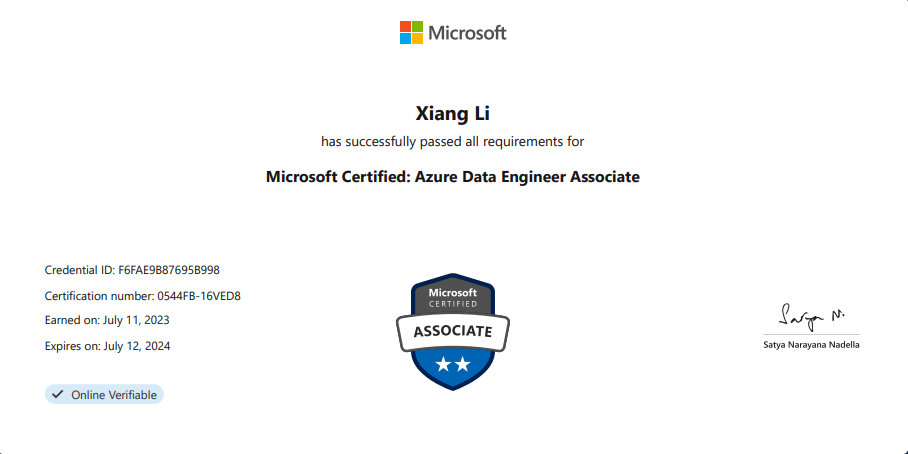
11/07/2023
Azure Data Engineer Associate
Data Pipeline
Streaming Analysis
Data Store, Movement and Transformation
Data Encryption
Databricks, Data Factory, Gen2

10/05/2024
Apache Airflow Fundamentals
Orchestration
Scheduling
Dataset
DAGs
Docker
Web Server

19/04/2024
Data Engineering Bootcamp
Data Pipeline
Data Warehousing
Analytics Engineer
Terraform
Bash
Docker
Python
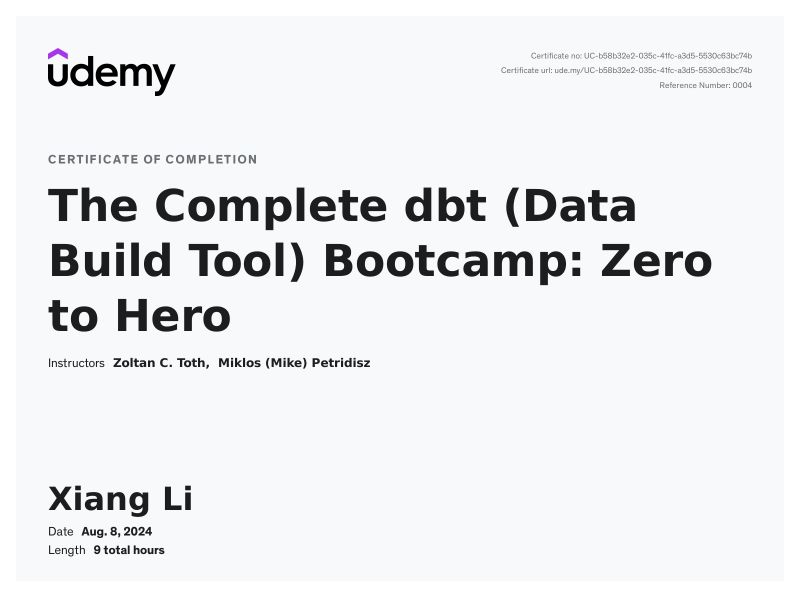
08/08/2024
dbt (Data Build Tool) Bootcamp
Modelling
Materialisation
Documentation
Macro
test
Snowflake
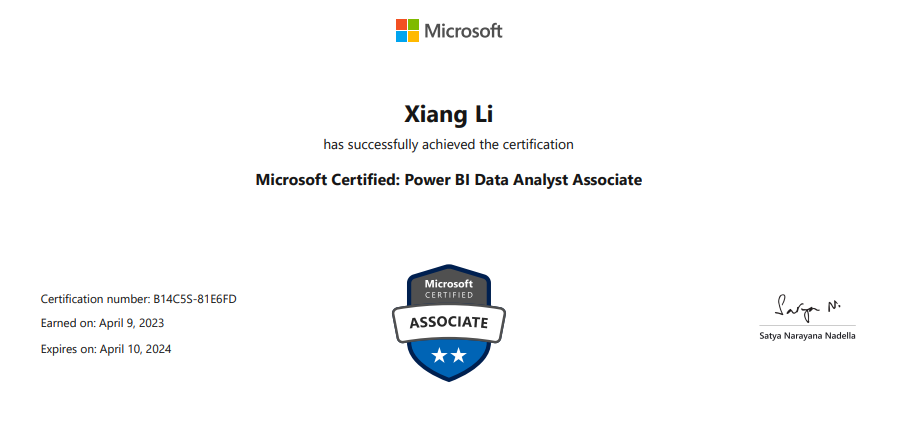
09/04/2023
Power BI Data Analyst Associate
Power BI Desktop
Power BI Service
Prepare Data
Model Data
Visualise and Analyse
Deploy and Maintan
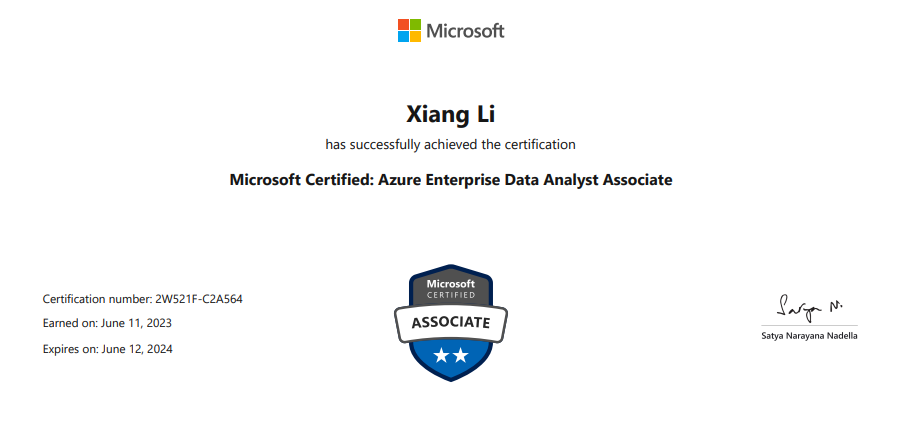
11/06/2023
Azure Enterprise Data Analyst Associate
Azure Synapse Analytics
Power BI
Microsoft Purview
Performance Optimisation
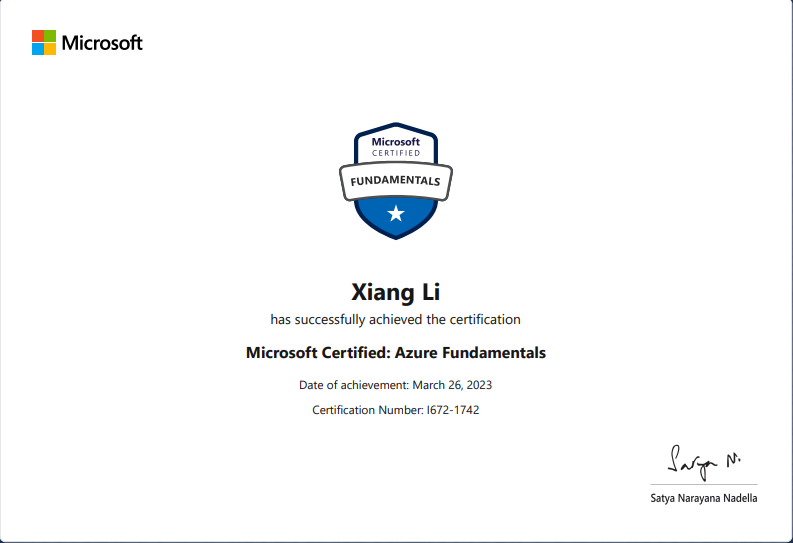
26/03/2023
Azure Fundamentals
Azure
Cloud Data
Cloud Networking
Cloud Security
Cloud Services
Cloud Storage
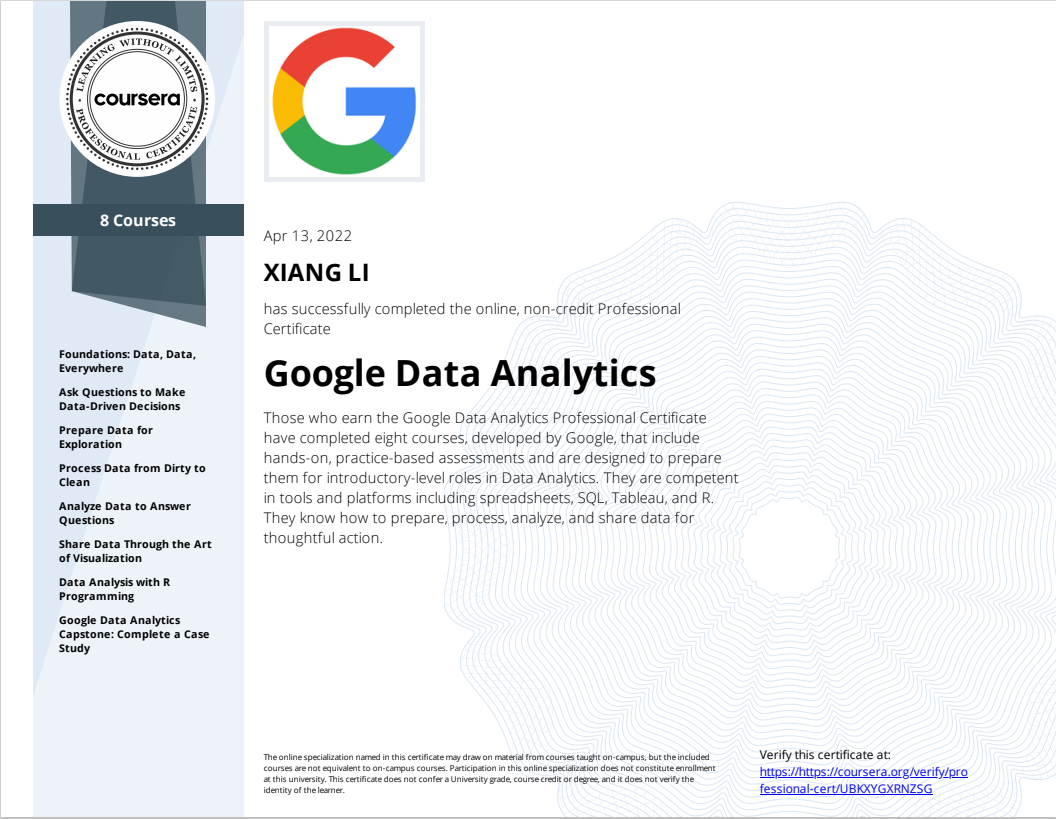
13/04/2022
Google Data Analytics
Spreadsheets
Tableau
R
SQL
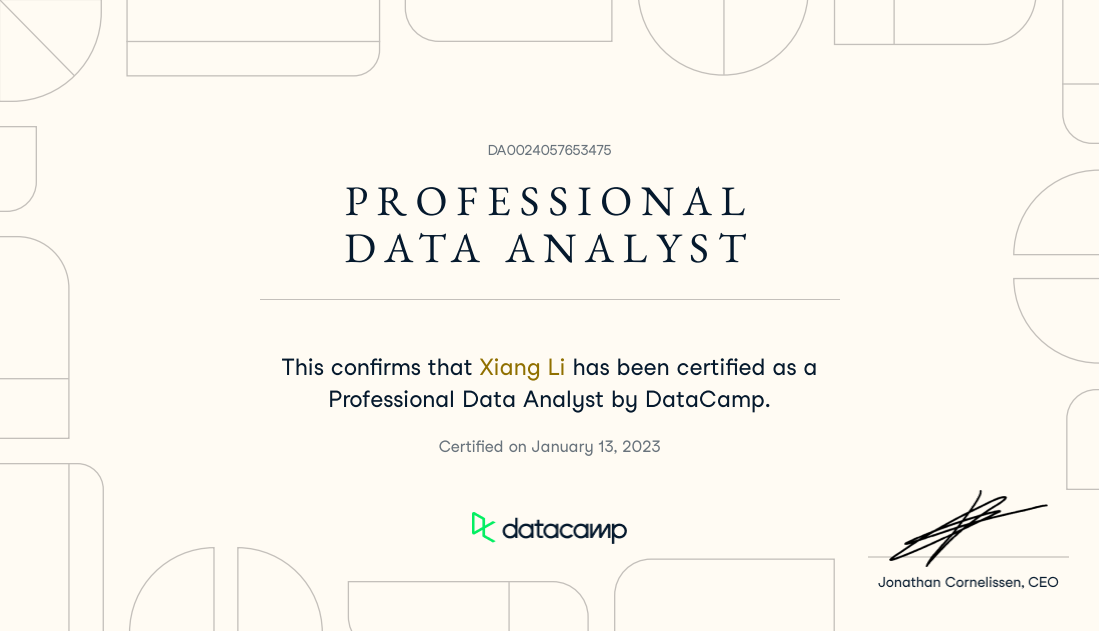
13/01/2023
Data Analyst Professional
SQL
R
Case Study
Presentation

17/03/2023
Data Science Bootcamp
Query databases
Design databases
Data Views
Transactions
Analytical Functions
Big Data
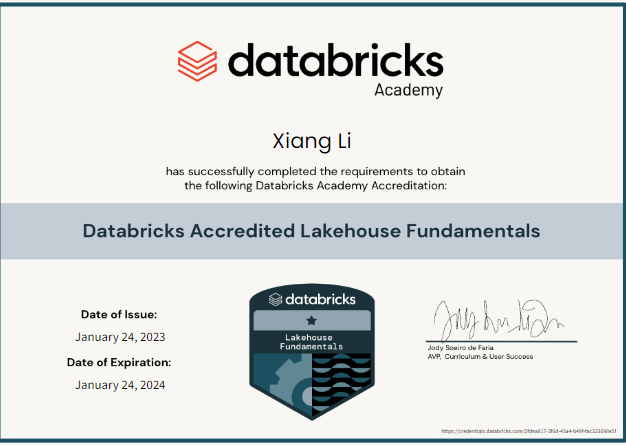
21/01/2023
Lakehouse Fundamentals
- Databricks